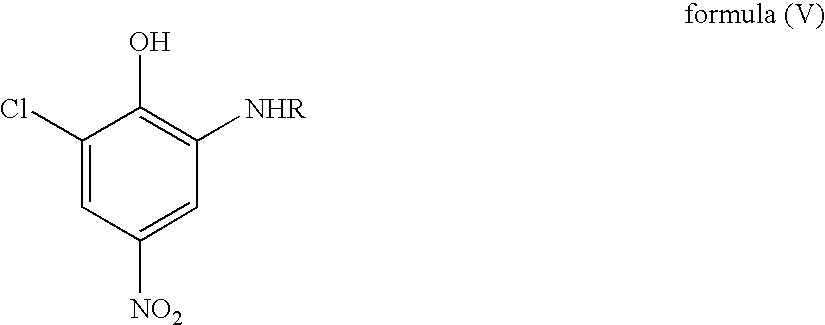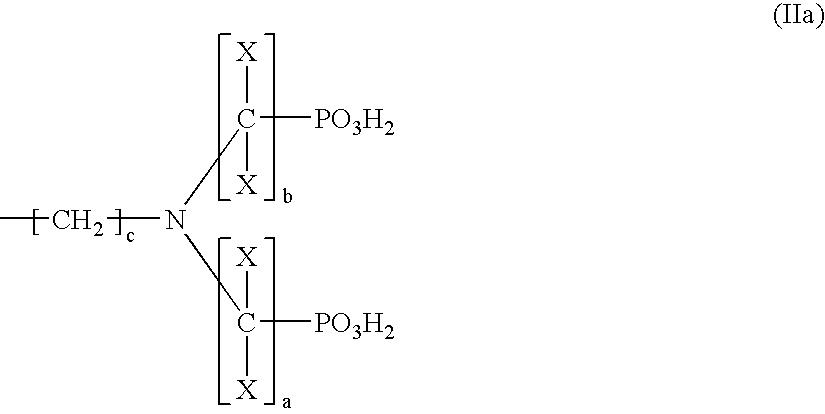Oxidizing Hair Colourant Compositions
a technology of hair colouring and compositions, applied in the direction of hair cosmetics, dyeing process, textiles and paper, etc., can solve the problems of reducing the tonality of oxidative colourants, so as to reduce prevent the damage to hair, and improve the hair feel
- Summary
- Abstract
- Description
- Claims
- Application Information
AI Technical Summary
Benefits of technology
Problems solved by technology
Method used
Image
Examples
examples
[0125]The following examples illustrate oxidative colouring compositions according to the present invention and methods of manufacture thereof. It is understood that the examples and embodiments described herein are for illustrative purposes only and that various modifications or changes in light thereof will be suggested to one skilled in the art without departing from the scope of the present invention.
example formulations
[0126]
12Sodium sulphite0.10.1Ascorbic Acid0.20.2Ethylenediaminetetracetic acid, disodium salt0.030.03Citric Acid0.20.2Ammonia(30% active)4.04.0Acrylates Copolymer(Aculyn ® 33A)1.01.0Oleth 50.50.5Oleth 21.01.0Oleic Acid0.90.9Cocamidopropyl betaine3.03.0Etidronic Acid0.050.05Isopropyl alcohol2.52.5Hydrogen Peroxide (35% active)8.613Soytrimonium Chloride and propylene glycol3.03.0Simethicone0.0030.003Steareth-211.01.0PEG-50 Hydrogenated Palmamide0.50.5Oleyl Alcohol0.20.2Acrylates Steareth-20 Methacrylate0.51.0Copolymer(Aculyn ® 22)Propylene Glycol2.02.0Ethoxy Diglycol4.24.2C11-15 Pareth-90.50.5C12-15 Pareth-30.80.8Diethylene-triamine-penta(methylene phosphonic) acid0.51.0p-phenylene diamine0.60.64-amino-2-hydroxytoluene0.60.6p-amino phenol0.250.251-napthol0.30.32-methyl-5-hydroxyethylaminophenol0.20.2pH adjust to pH 10qsqsWaterqsqsFormulationIngredient34Sodium sulphite0.10.1Ascorbic Acid0.10.1Ammonium Carbonate5.06.0Potassium Hydrogen Carbonate0.10.1Ammonium Acetate0.20.2Crodafos ® CES...
example formulations 7-12
[0127]
789101112Sodium sulphite0.10.10.10.10.10.1Ascorbic Acid0.20.20.20.20.20.2Ethylenediaminetetracetic acid, disodium0.030.030.030.030.030.03saltCitric Acid0.20.20.20.20.20.2Ammonia (30% active)4.04.04.04.04.04.0Acrylates Copolymer (Aculyn ® 33A)1.01.01.01.01.01.0Oleth 50.50.50.50.50.50.5Oleth 21.01.01.01.01.01.0Oleic Acid0.90.90.90.90.90.9Cocamidopropyl betaine3.03.03.03.03.03.0Etidronic Acid0.050.050.050.050.050.05Isopropyl alcohol2.52.52.52.52.52.5Hydrogen Peroxide (35% active)8.617.28.617.28.617.2Soytrimonium Chloride and propylene3.03.03.03.03.03.0glycolSimethicone0.0030.0030.0030.0030.0030.003Steareth-211.01.01.01.01.01.0PEG-50 Hydrogenated Palmamide0.50.50.50.50.50.5Oleyl Alcohol0.20.20.20.20.20.2Acrylates Steareth-20 Methacrylate0.51.00.51.00.51.0Copolymer (Aculyn ® 22)Propylene Glycol2.02.02.02.02.02.0Ethoxy Diglycol4.24.24.24.24.24.2C11-15 Pareth-90.50.50.50.50.50.5C12-15 Pareth-30.80.80.80.80.80.8Diethylene-triamine-penta(methylene0.51.00.51.0——phosphonic) acidEthylene ...
PUM
| Property | Measurement | Unit |
|---|---|---|
| wavelength | aaaaa | aaaaa |
| pH | aaaaa | aaaaa |
| melting point | aaaaa | aaaaa |
Abstract
Description
Claims
Application Information
 Login to View More
Login to View More - R&D
- Intellectual Property
- Life Sciences
- Materials
- Tech Scout
- Unparalleled Data Quality
- Higher Quality Content
- 60% Fewer Hallucinations
Browse by: Latest US Patents, China's latest patents, Technical Efficacy Thesaurus, Application Domain, Technology Topic, Popular Technical Reports.
© 2025 PatSnap. All rights reserved.Legal|Privacy policy|Modern Slavery Act Transparency Statement|Sitemap|About US| Contact US: help@patsnap.com



